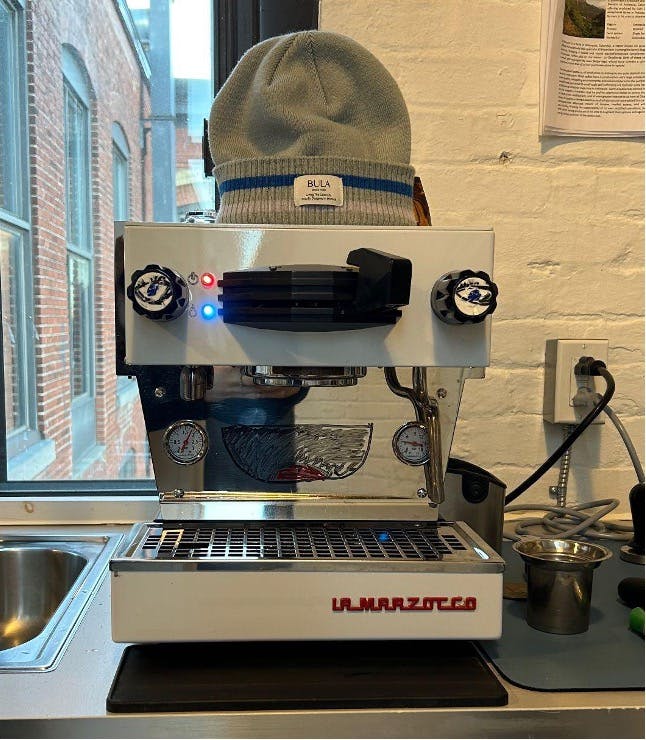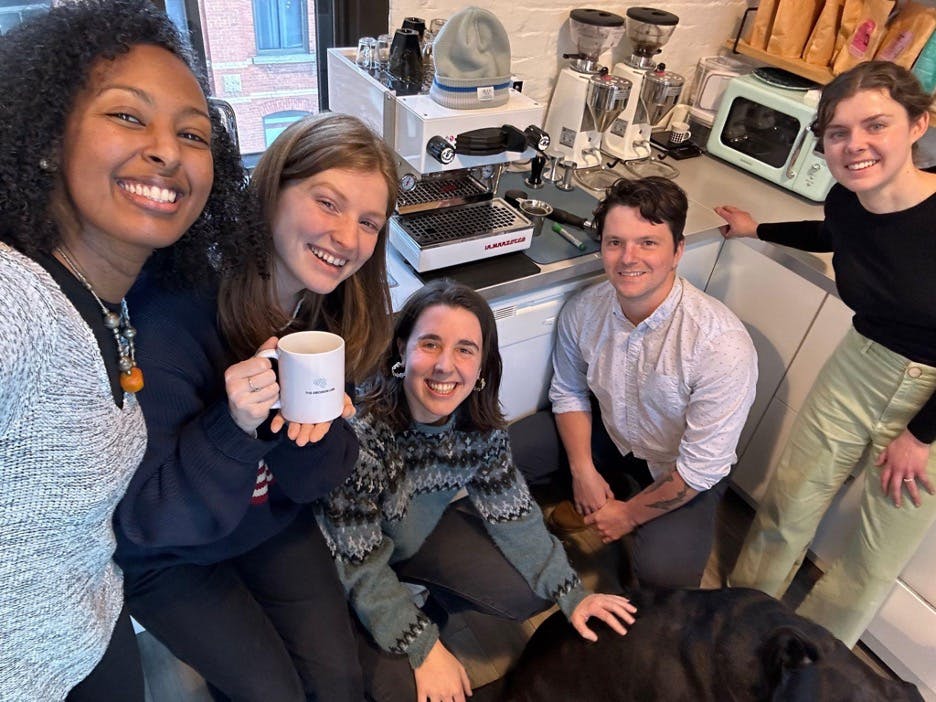Why Your Next Hire Should Be a Coffee Machine
Meet Linea “Mini,” the Senior Coffee Machine at The Decision Lab.

Hailing from the La Marzocco clan, Mini’s predecessors have found significant success in various organizations around the world. Unsurprisingly enough, Mini’s older sibling, “Linea Classic,” used to be the CCO (Chief Coffee Organizer) at the popular Starbucks chain for 15 years.
Like everyone else at The Decision Lab, Mini is a hard worker, always the first one in and the last to leave (in fact, we feel like they never leave the office).
When we asked Mini if they knew how important their role was at TDL, we got an empathetic “brnggghhh” followed by “pssssshhhhh” as they literally blew off some steam – all 1.8 bars of it to be exact – at the end of a long day of caffeinating the Montreal team.
Mini will never admit how critical their role is at the organization. Even though they’re not part of the consulting team, all of us here know that without Mini, we’d be asleep.
The funny thing is that Mini and their colleagues “Premium Health Insurance,” “UPTO,” and “Remote Work” are all part of a growing list of unofficial employees in organizations called perks. And the fact of the matter is, they’re not just a passing fad; they’re here to stay.
To better understand perks, along with motivation and employee retention, let’s take a moment to examine the behavioral science behind Mini and their friends.
Behavioral Science, Democratized
We make 35,000 decisions each day, often in environments that aren’t conducive to making sound choices.
At TDL, we work with organizations in the public and private sectors—from new startups, to governments, to established players like the Gates Foundation—to debias decision-making and create better outcomes for everyone.
So... what even are perks?
Perks are the real heroes of job negotiation.
They go beyond annual salary and monetary benefits, aiming to satisfy current and potential employees’ intrinsic desires. This includes important things like flexibility, career advancement, health benefits – and, of course, being caffeinated daily by a beloved coffee machine such as Mini.
Although we will never know when perks were first invented, our best guess is the Romans in 13 BC with the introduction of a pension plan for retired soldiers. Since then, they have been leveraged by employers and employees alike during negotiations to guarantee both job fulfillment and a workplace culture that meets everyone’s needs.
Let’s talk numbers.
Any cursory search online will show you how effective perks are. Just last year, an RBC Insurance study discovered that 66 percent of working Canadians who have access to benefits report their well-being as being good or even excellent compared to those without.
Let’s take a look at another study by Blue Cross of Canada, who determined that “since ‘health is wealth,’ nearly half (49%) of small business employees would rather have health benefits over a raise.” And it doesn’t stop there. “When offered a raise or health benefits, Canadian small business employees shared that they would rather have health benefits: 50% would rather have health benefits over a $10,000 raise.”
Of course, these numbers started to dwindle when offered pay increases of $25,000 (41 percent would choose health benefits) and $40,000 (now only 36 percent). However, no matter how you look at it, the numbers don’t lie: perks seal the deal.
Still not convinced? Let’s hear about how our own team at The Decision Lab allowed perks to influence their decision-making.
The reason I applied to the internship was the website boasting about the coffee machine.
Gabrielle Wasco, Content Editor on Mini
Well realistically I probably won’t be spending the majority of my time on vacation, so the word ‘unlimited’ is doing a lot of the heavy lifting here, but it’s really, really nice to have that kind of flexibility.
Jyn Moriles, Research Analyst on TDL’s unlimited paid time off policy
I don’t even use the coffee machine soooooooooooooo[ …] I guess hot water?
Sophie Cleff, Associate on tea(?)
What perks?
Hector Alvarado, Managing Director in a surprise Slack interview
Long story short: perks matter, and they play a big role in employee satisfaction.
But let’s dig a little bit deeper. What’s the behavioral science behind this all?
Intrinsic vs Extrinsic Motivation
For us to understand the power of perks, we first need to understand the two types of motivation: extrinsic and intrinsic.
Extrinsic motivation happens when people are motivated to accomplish something in exchange for an external reward – which, in this case, is a salary. On the flip side, intrinsic motivation is that which comes from within the employee. They are motivated to accomplish something because it itself is rewarding.
In the workplace, perks act as a catalyst for intrinsic motivation. This means that Mini might not be the reason you go to work every day, but having Mini around to “perk” you up (quite literally) is enough to help you get through yet another presentation. In short, perks create an environment that motivates you to work by enhancing your daily experience.
The beauty of perks is that people will still go to work for extrinsic rewards, but intrinsic motivation is what really drives their satisfaction, fostering the warm company culture we’re all looking for.
Self-Determination Theory (SDT)
Now that we’re familiar with intrinsic and extrinsic motivation, it’s time for us to tackle one of the most popular theories of motivation: self-determination theory. SDT attempts to explain why we feel intrinsically motivated to pursue and accomplish certain things.
According to this theory, there are three fundamental types of motivators:
- Autonomy
- Relatedness
- Competence
Now each of these motivators seems to tie quite neatly into the whole business of perks. Take “hybrid work” as an example. The whole essence of being away from an organization’s physical location not only boosts an employee’s sense of autonomy but signals to them that their employer trusts them.
Meanwhile, “Company Retreats,” “Team Building Activities,” and cultural exchanges are all catalysts for relatedness since they foster a sense of community and camaraderie within an organization.
As for competence, Mini’s best friend “Professional Development” shines the brightest. After all, offering the possibility to upskill highlights an organization's prioritization of its employees’ professional growth.
As you can clearly see, fostering autonomy, relatedness, and competence all neatly align to catalyze intrinsic motivation and achieve the goal of self-determination: making us feel good about ourselves. These perks don’t just address surface-level issues, but attempt to make caring and providing for employees the foundation of a company’s culture.
However, this doesn’t mean all of Mini’s friends are great for everyone. There are still complexities in finding the right perks for the right people – or even the right organization. Some benefits might initially look attractive on paper but end up causing company issues, while other perks might seem boring but actually have a good personality.
Let's understand this better by turning back to our favorite perk: Mini …and their problems.
The Problem with Perks
In early 2022, we decided that it was time to promote Mini, so we went on a journey to get them some benefits of their own. Unfortunately, this is where we started to see the problem with perks.
By studying the habits of our team, getting into discussions with them, and consulting professional materials, we were able to figure out what to get for Mini. It became clear that defining perks requires the cooperation of everyone in a company, not just who’s in charge.
However, after upgrading Mini, we hit another problem: we run a global team. Was it fair that Montreal’s Mini got the good stuff while other members across the world had to settle for “Nespresso” pods?
Now this was a problem that required a more systematic approach.
Apart from having to localize and personalize perks based on perceived value, we still had the challenge of stamping out fairness across our international teams. The real issue here was inclusivity, and the only way we could make sure that everyone was happy was to balance that out with a “Coffee Budget” for everyone outside of Montreal. Thus, introducing transparency and proper equity into the mix.
Beyond personalization and equity, there are still more reasons why some organizations might not like perks.

For one, perks can be absolutely distracting. Standing at 37.70 cm (without the cups on the warmer), Mini is a looker. We’ve often found the occasional TDLer spending way too much time chatting with Mini – which might not be problematic now, but we’re trying to change the world here folks, so get back to work!
Perks can often be used as a band-aid solution for real issues that exist in a company. Issues with management, strategy, employee relations, and culture can all be “cured” with perks, but only for so long.
Moreover, organizations also run the risk of getting too entitled. Take, for example, Mini’s ex (don’t worry, they’re so over it) at Google, “Free Gourmet Lunches.” Although one of the most popular perks in this specific workplace, this kind of luxury still can’t be deployed in smaller organizations with even smaller budgets.
The honest truth is that we will never find the “perfect perk.” Even an almost perfect perk like Mini is very dependent on how it is deployed, communicated, and received by those within a company. Perks drive intrinsic motivation, but will never fully substitute proper organizational governance and addressing institutionalized issues head-on.
What Does This Mean for Me?
If you run an organization or are in charge of a lot of people, don’t go out running to get yourself a Linea Mini just yet (although we all highly recommend it). We’ve determined that perks can make people’s lives easier and even more enjoyable, but that doesn’t mean every perk is going to gain traction in your workplace. The trick to looking for perks that work for work is to ask yourself this question: “Does this perk drive temporary happiness or intrinsic motivation?”
There are indeed a lot of Mini’s out there, but only some of them make sense. In a study done by Fractl of 17 different perks, “Better health, dental, and vision insurance,” “more flexible hours,” and “more vacation time” dominate the top of the list. Although these can’t be afforded by all organizations, the mere notion of customizing perks by understanding what drives individual employees to be motivated seems to be the right roadmap. For instance, if your company is budget-constrained, it’s worth looking at indirect attacks on budget such as flexible hours.
In salary negotiations, being able to leverage perks can be an effective tool for both parties when extrinsic motivations such as salary and company reputation are not cutting it. Being able to instead ask for better health benefits, for example, can often bridge expectations between employers and potential employees.
Despite always being at a loss for words, Mini is probably going to be promoted to CHO (Chief Happiness Officer) or CCO (Chief Coffee Organizer – like their older sibling!) very soon. They hope that whether your organization is rocking a Breville, Nespresso, or vouchers from Timmies, you get to appreciate them a little bit more after knowing their story.
About the Author
Monty Tengco
Monty Tengco is a Senior Venture Associate at The Decision Lab. He has a degree in Economics and Public Policy, specializing in operations and marketing strategy. Prior to joining The Decision Lab, he’s held various project management roles in digital marketing. He’s also served in business development consultancy roles ranging from co-working spaces to a monastery. In his personal time, he does volunteer work and enjoys cooking.





